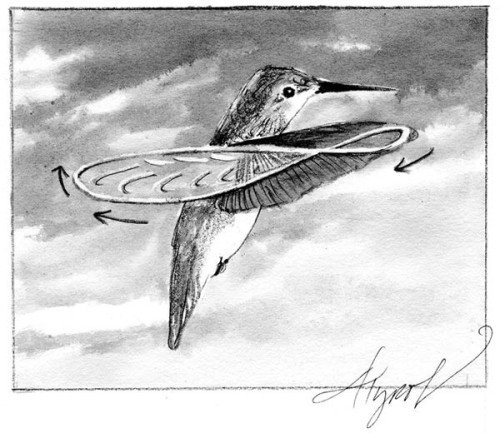
As the summer bird chorus wanes, we might remember that song can arrive in unexpected ways. Drumming heads, clacking bills, and dancing feet create nonvocal sound. Even flight, that foremost avian feat, creates music of its own.
Wings can sing – sound is created by the asymmetry, anatomy, and arrangement of individual flight feathers as they vibrate through the air. A number of birds use wing song to communicate, both with their own species and as a way to thwart predators.
Dramatic lift offs can match the best vocal alarms. The explosive flight of a ruffed grouse may distract (or frighten) its enemies just long enough to effect an escape. The volatile burst of wings produces a miniature sonic boom as air rushes to fill the vacuum between the powerful wing beats. Similarly, mourning doves warn others as they rise on whistling wings. That sound, which is common among many pigeons and doves, accelerates in tempo among a group of distressed birds to incite a faster dispersal.
The wing songs of the breeding season are perhaps the most remarkable. Instead of its single alarm-boom, the courting male ruffed grouse produces a quickening series of whirring thumps to bring mates in and keep other males away. These highly territorial males usually perform on drumming logs ten to twelve inches above ground to best transmit their thunderous sounds. While breeding season peaks in April, you can often catch a repeat drumming performance in October.
Most birds that utilize wing songs in breeding performances do so in flight. After a series of preparatory nasal peents from the ground, the courting male American woodcock spirals to the sky in resplendent twittering. His ascending sounds are not vocal. Instead, they depend on flight feathers with short, widely spread margins that vibrate in the air like a string. The woodcock rises 200-300 feet, then tumbles down in liquid warbling to the very same spot, only to begin the vertical wing song again. Although particular behaviors and tones are distinct, similar performances are heard among others in the sandpiper family. The Wilson’s snipe is a renowned example from our region. It exhibits a rising breeding dance much like the woodcock, but its tight, pointed wings create a hoot-like, winnowing howl.
It is clear that the shape of the wing affects the pitch of these kamikaze courtiers. Longer, sharper wing and feather shapes typically create sounds with deeper dramatic force. The booming dives of common nighthawks, whose wings are long and scimitar shaped, are an extreme example on the low end of the audio spectrum. Hummingbirds perform opposing variations on this theme, with tiny, jackknife wings that pierce notes with the highest violins. Chris Clark, an ornithologist at Yale University who specializes in the biomechanics of hummingbird tails, suggests the intricate music of bird wings began as incidental sounds in flight, like the tread of walking feet. But over time, males with the most dramatic, free-falling songs were most successful passing on their genes.
Charles Darwin also discussed the evolutionary purpose of wing song in The Descent of Man: “In the case of modified feathers by drumming, whistling, or roaring noises produced, we know that some birds during their courtship flutter, shake, or rattle their unmodified feathers together…” Today we can use super slow motion videos and Doppler vibrometers to see the mechanics of wing song. But there is still much to learn about their origins and their functions, which can be as miraculous as flight itself.

